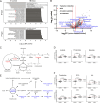The prebiotic potential of dietary onion extracts: shaping gut microbial structures and promoting beneficial metabolites
- PMID: 39714164
- PMCID: PMC11748487
- DOI: 10.1128/msystems.01189-24
The prebiotic potential of dietary onion extracts: shaping gut microbial structures and promoting beneficial metabolites
Abstract
Onions are well-known vegetables that offer various health benefits. This study explores the impact of onion extracts on gut microbiome using an in vitro fecal incubation model and metabolome analysis. Fecal samples were collected from 19 healthy donors and incubated in the presence or absence of onion extracts for 24 h. To reduce inter-individual variability in the gut microbiome, we employed enterotyping based on baseline fecal microbiota: 14 subjects with a Bacteroides-dominant type (enterotype B) and 5 subjects with Prevotella-dominant type (enterotype P). Alpha diversity was significantly reduced in the onion-treated group compared to the non-treated control group in both Bacteroides- and Prevotella-dominant types. However, significant structural differences in bacterial communities were observed based on weighted UniFrac distance. Notably, short-chain fatty acid (SCFA)-producing bacteria, such as Bifidobacterium_388775, Feacalibacterium, and Fusicatenibacter, were overrepresented in response to onion extracts in enterotype B. Furthermore, genes related to butyrate production were significantly overrepresented in the onion-treated group within enterotype B. Consistent with the enriched taxa and the predicted metabolic pathways, SCFAs and their related metabolites were significantly enriched in the onion-treated group. Additionally, tryptophan metabolism-derived metabolites, including indolelactate (ILA) and indolepropionate (IPA), were elevated by 4- and 32-fold, respectively, in the onion-treated group compared to the control group. In vitro growth assays showed an increase in lactobacilli strains in the presence of onion extracts. These results provide evidence that onion extracts could serve as promising prebiotics by altering gut microbial structure and promoting the production of beneficiary metabolites, including SCFAs and indole derivatives, and enhancing the growth of probiotics.IMPORTANCEThis study is significant as it provides compelling evidence that onion extracts have the potential to serve as effective prebiotics. Utilizing an in vitro fecal incubation model and enterotyping to reduce inter-individual variability, the research demonstrates how onion extracts can alter gut microbial structure and promote the production of beneficial metabolites, including SCFAs and indole derivatives like ILA and IPA. Additionally, onion extract treatment enhances the growth of beneficial probiotics. The findings underscore the potential of onion extracts to improve gut health by enriching specific beneficial bacteria and metabolic pathways, thereby supporting the development of functional foods aimed at improving gut microbiota composition and metabolic health.
Keywords: enterotype; gut microbiome; metabolites; onion extracts; prebiotics; short-chain fatty acids; tryptophan metabolism.
Conflict of interest statement
The authors declare no conflict of interest.
Figures





Similar articles
-
Impact of 2'-fucosyllactose on adult gut microbiota composition and metabolome based on colonic fermentation and prebiotic quantitative evaluation.J Food Sci. 2025 Mar;90(3):e70084. doi: 10.1111/1750-3841.70084. J Food Sci. 2025. PMID: 40135481
-
Gut enterotypes are stable during Bifidobacterium and Lactobacillus probiotic supplementation.J Food Sci. 2020 May;85(5):1596-1604. doi: 10.1111/1750-3841.15127. Epub 2020 Apr 8. J Food Sci. 2020. PMID: 32267970
-
Novel cross-feeding human gut microbes metabolizing tryptophan to indole-3-propionate.Gut Microbes. 2025 Dec;17(1):2501195. doi: 10.1080/19490976.2025.2501195. Epub 2025 May 7. Gut Microbes. 2025. PMID: 40336187 Free PMC article.
-
Examining the potential prebiotic effect of almonds.J Appl Microbiol. 2025 Apr 1;136(4):lxaf078. doi: 10.1093/jambio/lxaf078. J Appl Microbiol. 2025. PMID: 40156575 Review.
-
How Do Cyclodextrins and Dextrans Affect the Gut Microbiome? Review of Prebiotic Activity.Molecules. 2024 Nov 11;29(22):5316. doi: 10.3390/molecules29225316. Molecules. 2024. PMID: 39598705 Free PMC article. Review.
References
-
- Hertog MGL, Hollman PCH, Katan MB. 1992. Content of potentially anticarcinogenic flavonoids of 28 vegetables and 9 fruits commonly consumed in the Netherlands. J Agric Food Chem 40:2379–2383. doi:10.1021/jf00024a011 - DOI
-
- Santas J, Carbo R, Gordon M, Almajano M. 2008. Comparison of the antioxidant activity of two Spanish onion varieties. Food Chem 107:1210–1216. doi:10.1016/j.foodchem.2007.09.056 - DOI
-
- Ketiku AO. 1976. The chemical composition of Nigerian onions (Allium cepa, Linn). Food Chem 1:41–47. doi:10.1016/0308-8146(76)90013-3 - DOI
MeSH terms
Substances
Grants and funding
LinkOut - more resources
Full Text Sources
Molecular Biology Databases
Research Materials

